Sponsored Content by OpentronsReviewed by Louis CastelMar 29 2024
The Opentrons Flex™ is a modular benchtop liquid handling platform that can be used to automate even the most laborious procedures, such as small-scale protein purification, nucleic acid extraction, and NGS library preparation.

Figure 1. The Opentrons Flex is a new lab automation platform that is highly modular and able to automate a variety of different life science workflows. Image Credit: Opentrons
Introduction
Automation is a vital tool, helping life scientists increase throughput, reduce hands-on time, improve uniformity, and reduce mistakes. However, automation also presents several obstacles, including platforms that are either highly customized but costly and complex or simple and economical but limited to certain operations. There is now a push for laboratory automation that is easily accessible, easily programmable, and easily implemented.
This article will thus explore the automation of three widely used life science workflows—small-scale protein purification, NGS library preparation, and nucleic acid extraction—on a novel automation platform, Opentrons Flex, and demonstrate how highly accurate results can be obtained on a flexible system that is easy-to-implement into a wide range of life science labs.
Platform overview
Opentrons Flex is a liquid-handling robot that has been specifically designed for high throughput and complex workflows.
At the base of the modular system is the Flex robot itself, which includes pipettes, a labware gripper, on-deck modules, and labware — all of which can be swapped out as and when it is needed.
Flex features an integrated touchscreen so that users can work directly at the bench with this system or control it from across the lab with the Opentrons App using Opentrons' open-source APIs.
Key features of the Opentrons Flex
- Gripper to extend walkaway time: To increase throughput and walkaway time, the Flex Gripper can move plates and tip racks across the deck or on and off modules.
- Accurate pipettes with wide range volumes: Dependable liquid transfers using swappable 1-, 8-, and 96-channel pipettes that have automatic positional calibration from 1 to 1000 µL.
- Touchscreen for easy protocol setup: Using the touchscreen, choose and execute protocols right from the lab bench. Users are also guided through automatic calibration and deck setup via the touchscreen.
- Modulate to fit the workflow: Opentrons' modules integrate effortlessly with Opentrons robots and software and can be readily swapped out as and when required. Users can choose from the on-deck thermocycler, heater-shaker, temperature module, and magnetic block.
The Flex robot can be used with a variety of Flex workstations that include application-specific hardware, labware, and custom protocol development:
- With the Opentrons Flex NGS Workstation, users can automate NGS library preparation at the volume required to boost productivity, lower error rates, and cut down on manual labor. Automate every step of the pre-sequencing process, including the chemical processes based on fragmentation and tagmentation.
- The Opentrons Flex Protein Purification Workstation automates small-scale protein purification and proteomics sample preparation for up to 96 samples. This workstation is compatible with commonly used magnetic bead-based reagents.
- Opentrons Flex Nucleic Acid Extraction Workstation automates DNA/RNA isolation and purification. This workstation includes a Flex Magnetic Block for the separation of magnetic beads and an Opentrons Heater-Shaker for sample lysis and resuspension.
- Opentrons Flex PCR Workstation automates PCR setup and thermocycling for up to 96 samples. Fill a 96-well PCR plate with cooled reagents and samples. Use the Flex Gripper to place the plate onto the on-deck thermocycler on the Flex deck. Run the desired PCR program.
- The Opentrons Flex Aliquoting Workstation automates aliquoting samples or reagents from tubes onto 96-well plates. This workstation automates tedious and time-consuming activities in many laboratories.
Flex workstations offer customizable hardware modules and pipette options to meet the demands of various processes (see example deck layouts in Figure 2).
Application data
Opentrons carried out testing with biological samples and popular reagent kits to demonstrate the capabilities of Flex for delivering consistent and accurate results across a range of different applications.
Nucleic acid extraction
The Flex allows for the efficient automation of nucleic acid extraction. The suggested deck layout includes reservoirs, tip racks and deep well plates required for high-volume binding and wash steps (Figure 2a).
This configuration includes the Opentrons Flex Magnetic Block, Opentrons Heater-Shaker Module, and Opentrons Temperature Module for bead pelleting, resuspension, and cooling sensitive reagents or samples, respectively.
Figure 3 highlights the efficiency of a 48-sample format extraction protocol. DNA extracted from HeLa cells on the Opentrons Flex shows high integrity and purity ready for downstream applications and analysis (Figure 3).
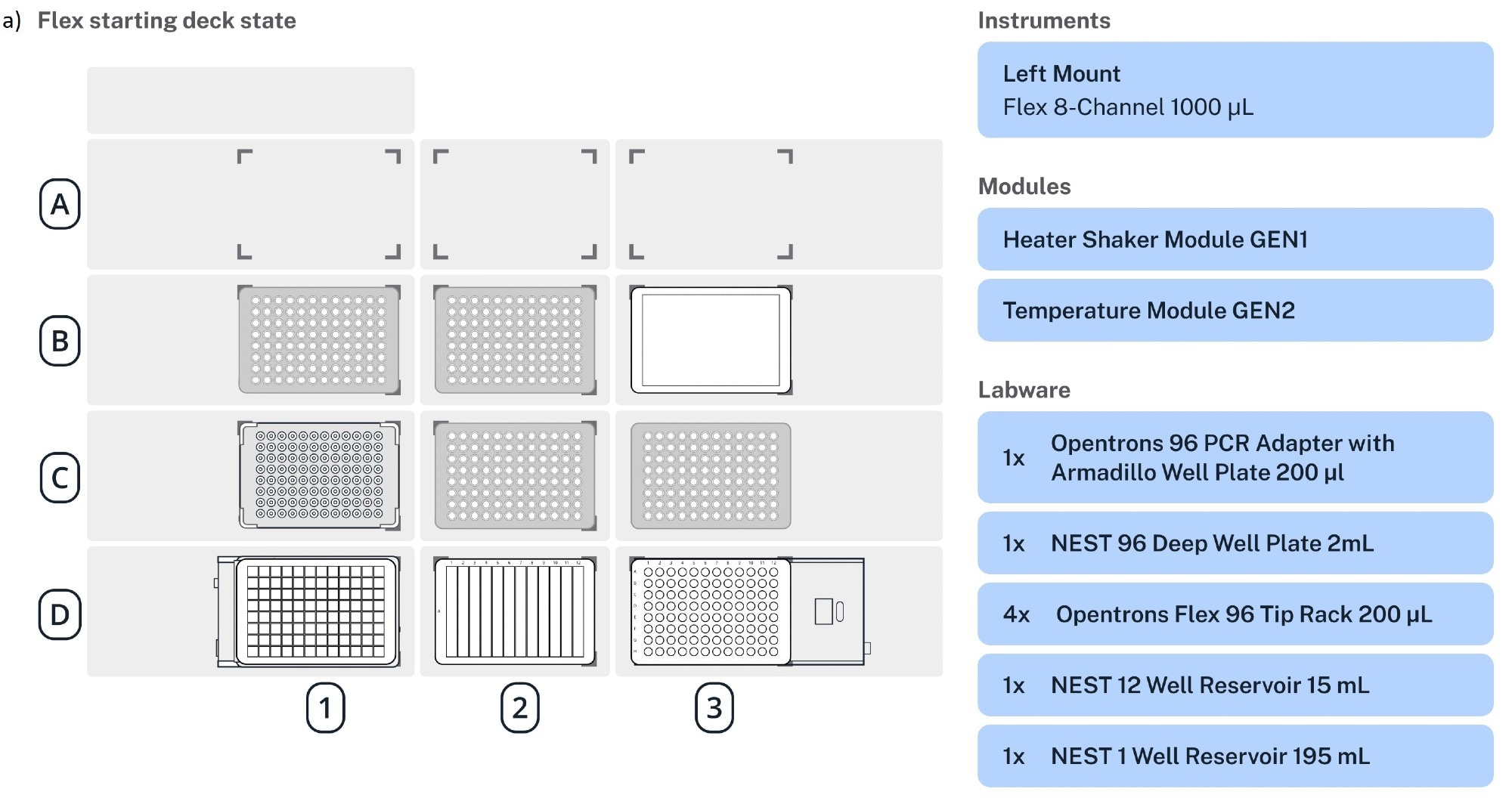
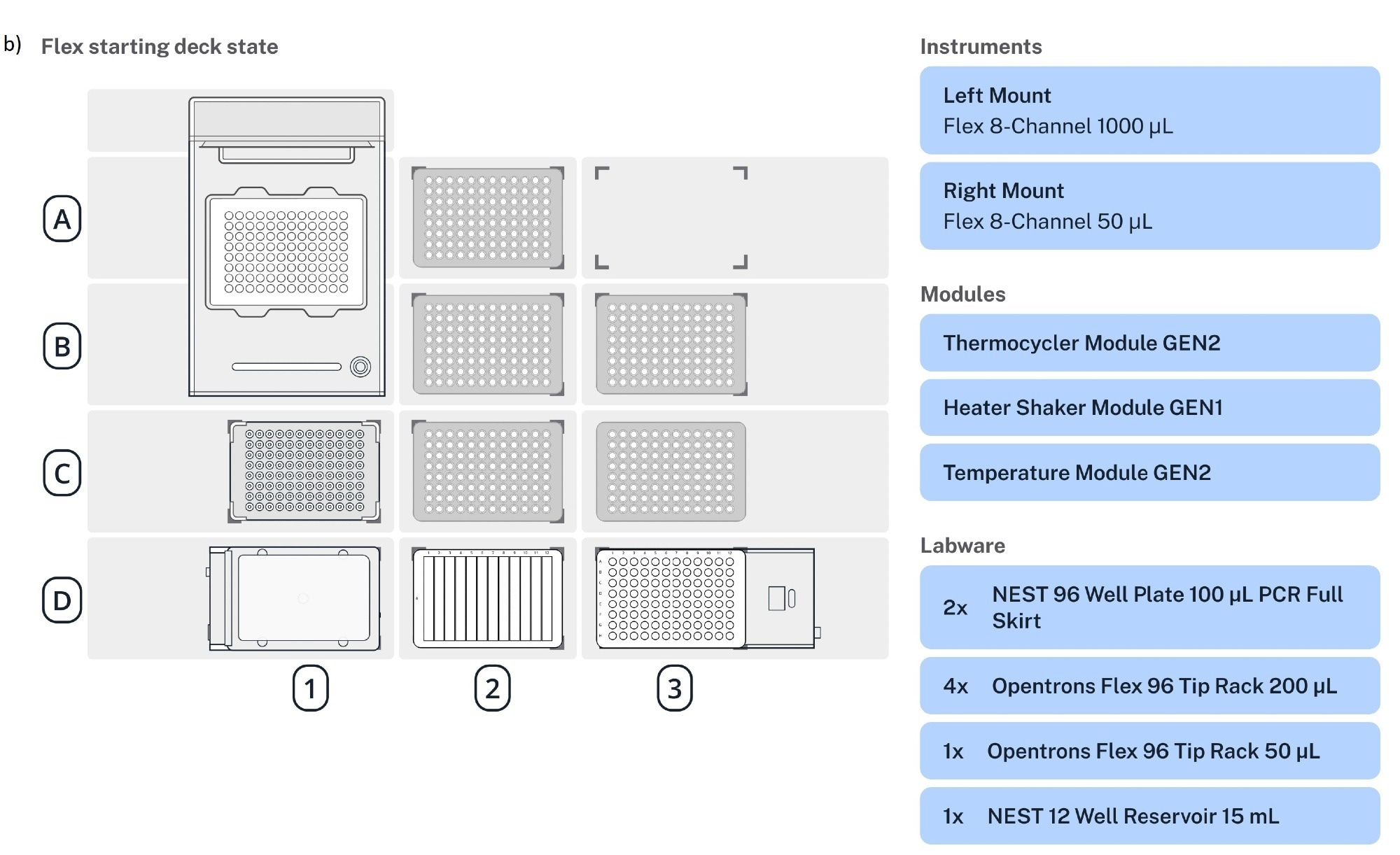
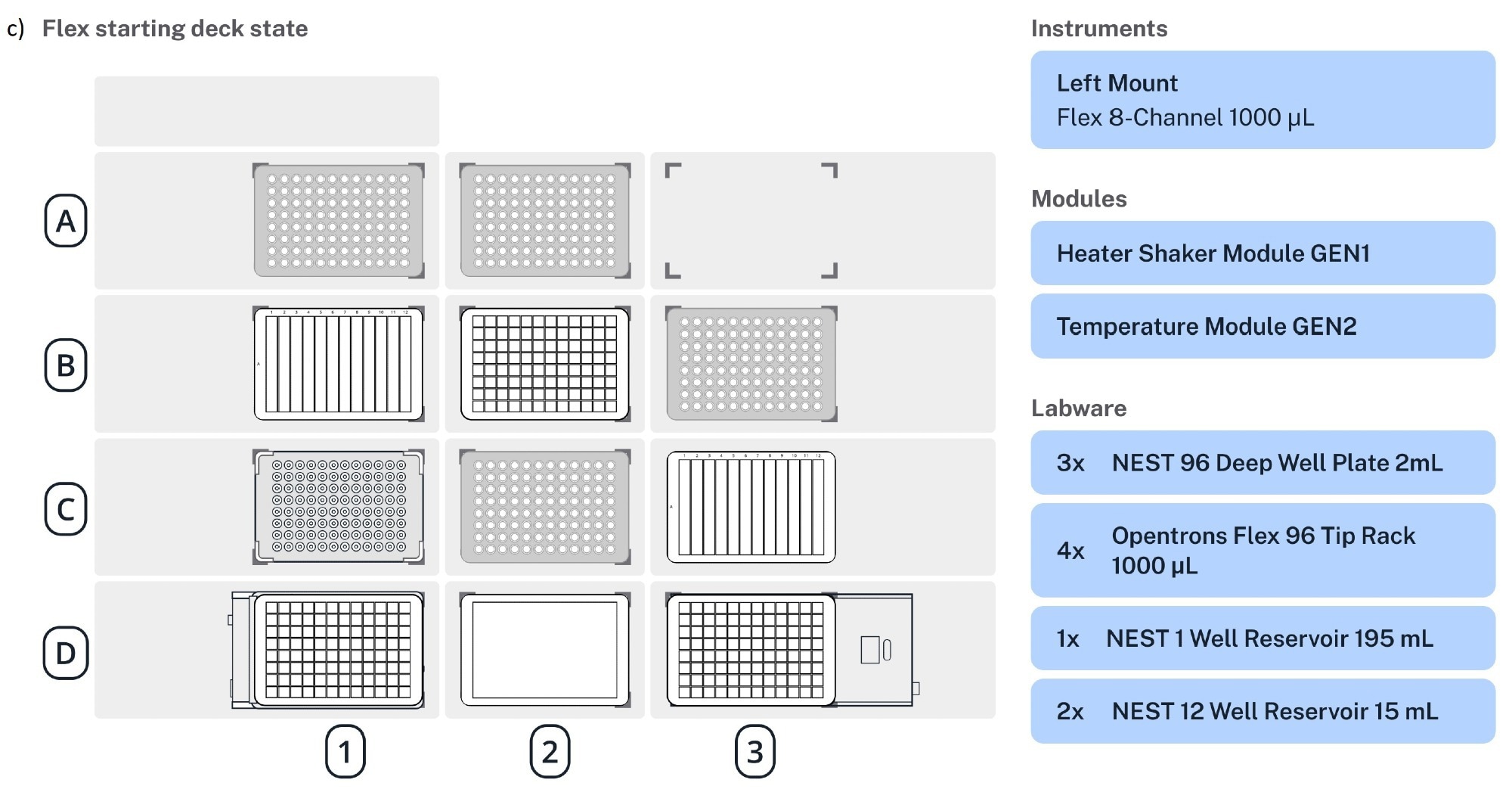 Figure 2. Example deck layouts and pipette configurations for three popular applications, (a) nucleic acid extraction,(b) NGS library prep, and (c) small-scale protein purification. Image Credit: Opentrons
Figure 2. Example deck layouts and pipette configurations for three popular applications, (a) nucleic acid extraction,(b) NGS library prep, and (c) small-scale protein purification. Image Credit: Opentrons
| |
DIN |
A260/280 |
| Average |
9.41 |
1.90 |
| CV (%) |
0.79 |
0.96 |
Figure 3. Automated nucleic acid extraction from HeLa cells on the Opentrons Flex results in extracted DNA with a high average DNA Integrity Number (DIN) and 260/280 absorbance ratio, ready for downstream applications. Image Credit: Opentrons
NGS library prep
The Flex provides effective automation for NGS library preparation. The workflow uses the on-deck Opentrons Thermocycler Module, Flex Magnetic Block, Heater-Shaker Module, and Temperature Module.
The thermocycler can be used for high-temperature enzymatic incubations and indexing while providing stable sample plate storage for the subsequent clean-up steps. Using the gripper allows for optimal walkaway time, even for these complex workflows.
NGS library preparation with enzymatic fragmentation of genomic E. coli DNA was highly uniform on the Opentrons Flex, as shown by the consistent fragment distribution from Tapestation analysis (Figure 4). The sequenced libraries produced accurate and highly mappable reads using an Illumina® MiSeq® for sequencing.
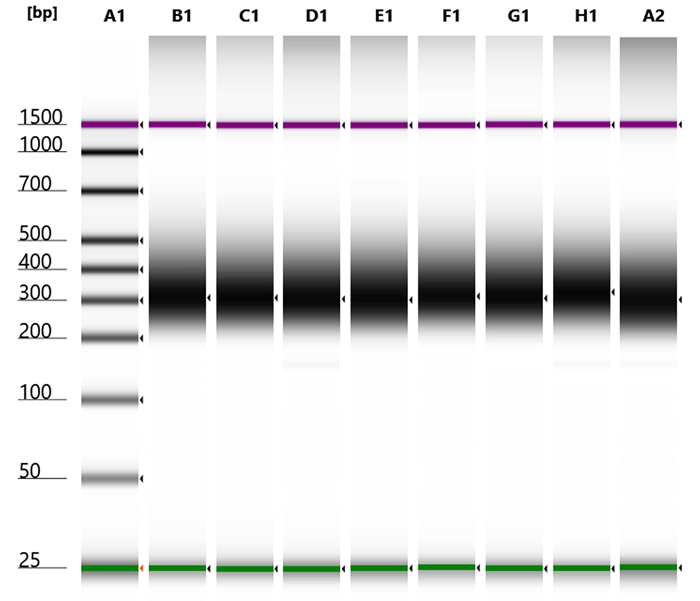
| |
Size (bp) |
Mapped (%) |
Index CV |
Duplicate (%) |
Error Rate (%) |
| Average |
264 |
99.04 |
0.6 |
0.6 |
0.10 |
| CV (%) |
2.77 |
0.05 |
- |
- |
- |
Figure 4. Expected size distribution, high uniformity, and low coefficient of variation (CV) of NGS libraries constructed from genomic E. coli DNA on the Opentrons Flex. Image Credit: Opentrons
Protein purification
With the Opentrons Flex, small-scale protein purification with magnetic beads can be effectively automated. The Opentrons Flex Magnetic Block, Opentrons Heater-Shaker Module, and Opentrons Temperature Module were utilized in the workflow to pellet protein magnetic beads, resuspension, and cooling of sensitive reagents or samples, in that order.
In the figure below, it is shown that the target protein, recombinant GAPDH, can be consistently captured by automated immunoprecipitation utilizing Protein G beads, with a consistent CV across samples.
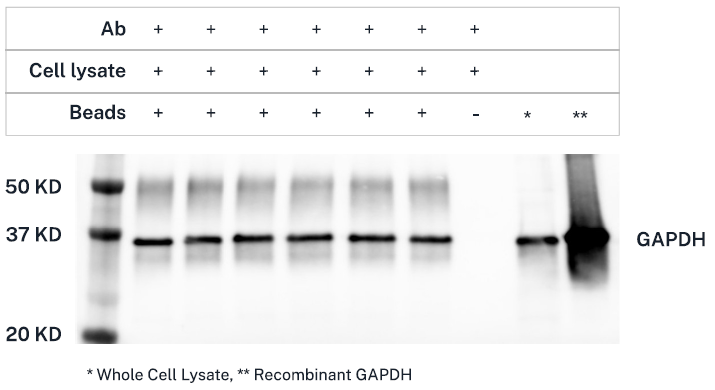
Figure 5. High efficiency and consistent coefficient of variation (CV) across samples for isolation of recombinant GAPDH on the Opentrons Flex. Image Credit: Opentrons
Conclusion
This article successfully demonstrates that automating three common life science workflows—small-scale protein purification, NGS library preparation, and nucleic acid extraction—on the Opentrons Flex yields remarkably precise and consistent results.
Laboratory scientists can quickly modify the Flex robot with pipettes, hardware, and labware required for various applications for these or several more applications.